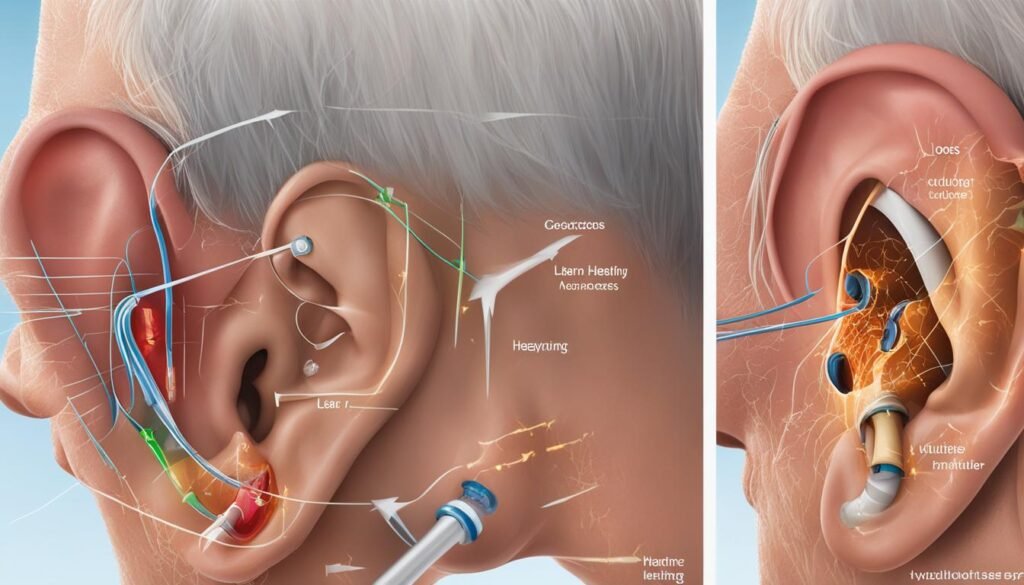The difference between sensorineural and conductive hearing loss is key in determining the right treatment options for hearing impairment. These two common types of hearing loss, while both affecting hearing, have distinct causes and require different management and treatment approaches. Sensorineural hearing loss is typically caused by inner ear or auditory nerve damage, often resulting from ageing, noise exposure, or certain medical conditions. On the other hand, conductive hearing loss occurs when sound waves are prevented from reaching the inner ear, usually due to obstructions or malformations in the outer or middle ear.
Understanding these differences is crucial for healthcare providers and patients, as it guides the diagnosis and intervention strategies. This article will delve into the specific characteristics of each type, their causes, and the most effective treatment methods.
Key Takeaways:
- Damage or issues within the inner ear or auditory nerve cause sensorineural hearing loss.
- Conductive hearing loss is typically the result of obstructions or problems in the outer or middle ear.
- Sensorineural hearing loss is often permanent, while conductive hearing loss is often treatable.
- Symptoms of sensorineural hearing loss may include difficulty understanding speech and muffled sounds.
- Symptoms of conductive hearing loss may include a decrease in volume or clarity of sounds and a sensation of fullness in the ear.
- Treatment options for sensorineural hearing loss may include hearing aids and cochlear implants.
- Treatment for conductive hearing loss depends on the underlying cause and may involve removing obstructions, treating infections, or surgical interventions.
Symptoms and Causes of Sensorineural Hearing Loss
Sensorineural hearing loss is a type of hearing loss that occurs when there is damage or a problem within the inner ear or the auditory nerve. This can result in permanent hearing loss. There are several causes of sensorineural hearing loss, including:
- The natural ageing process (presbycusis)
- Exposure to loud noises (noise-induced hearing loss)
- Viral infections
- Injury
- Certain medications (ototoxic hearing loss)
Some symptoms of sensorineural hearing loss:
- Difficulty understanding speech
- Muffled or distorted sounds
- The need for increased volume to hear
It’s important to seek medical attention if you experience any of these symptoms, as early diagnosis and intervention can help manage the condition and improve quality of life.
Understanding the Causes
A variety of factors can cause sensorineural hearing loss. The natural ageing process is a common cause, as the delicate structures of the inner ear can deteriorate over time. Exposure to loud noises, such as music or occupational noise, can also contribute to sensorineural hearing loss.
It’s important to protect your ears from loud noises by wearing earplugs or earmuffs in noisy environments, and by keeping the volume at a safe level when using headphones or earbuds.
Viral infections like measles or mumps can affect the inner ear and lead to sensorineural hearing loss. Additionally, certain medications, such as chemotherapy drugs and certain antibiotics, can have ototoxic effects and cause damage to the auditory system.
Managing Sensorineural Hearing Loss
While sensorineural hearing loss is usually permanent and cannot be reversed with medicine or surgery, treatment options are available to help improve hearing ability. Hearing aids are a common solution for sensorineural hearing loss, as they amplify sound frequencies and can be customized to individual needs.
Hearing aids can help individuals with sensorineural hearing loss by making sounds louder and clearer, allowing for better communication and engagement in daily activities.
Cochlear implants may be recommended in more severe cases of sensorineural hearing loss. These devices bypass the damaged parts of the inner ear and directly stimulate the auditory nerve, providing a sense of sound to those who cannot benefit from hearing aids alone.
Symptoms and Causes of Conductive Hearing Loss
Conductive hearing loss is characterized by a decreased ability to hear sounds clearly due to a blockage or obstruction in the outer or middle ear. This hearing loss can range from mild to severe, depending on the underlying cause. Understanding the symptoms and causes of conductive hearing loss is crucial for early detection and appropriate treatment.
Symptoms of Conductive Hearing Loss:
- Decreased volume or clarity of sounds
- A sensation of fullness or pressure in the ear
- Ear pain or discomfort
Individuals with conductive hearing loss may also experience difficulty understanding speech, especially in noisy environments. These symptoms can significantly impact communication and quality of life if left untreated.
Causes of Conductive Hearing Loss:
There are several potential causes of conductive hearing loss, including:
- Ear infections or otitis media
- A buildup of earwax or cerumen
- Blockage or damage to the ear canal
- Perforation of the eardrum
- Malformation of the outer or middle ear
In some cases, conductive hearing loss may be temporary and resolved with medical treatment or obstruction removal. However, if left untreated or the underlying cause is more severe, it can lead to long-term hearing impairment.

Early diagnosis and intervention are crucial for managing conductive hearing loss effectively. If you or a loved one is experiencing any symptoms or suspect hearing loss, it is important to seek the advice of a qualified healthcare professional who can provide appropriate evaluation and treatment options.
Diagnosis and Evaluation
Diagnosing and evaluating hearing loss requires a comprehensive approach, including a thorough history and physical examination. The process starts with the healthcare professional asking questions about the onset of hearing loss, any associated symptoms, family history, and medical history. These details help determine the potential causes of the hearing loss and guide the diagnostic process.
Physical examination plays a crucial role in evaluating hearing loss. One common procedure is otoscopy, which involves examining the ear canal and eardrum using an otoscope. This allows the healthcare professional to identify any abnormalities or obstructions contributing to the hearing loss.
The Weber’s test and Rinne test are commonly performed to assess hearing abilities. The Weber’s test involves placing a tuning fork on the forehead to determine if the sound is heard equally in both ears. The Rinne test compares air conduction to bone conduction by placing a tuning fork on the mastoid bone behind the ear and then in front of the ear. These tests help in identifying the type and degree of hearing loss.
Formal audiography, a hearing test, is essential for a comprehensive evaluation. It involves using specialized equipment to measure hearing abilities and identify the specific frequencies and volumes at which a person may have difficulty hearing. This information helps in developing appropriate treatment plans tailored to individual needs.

Key Points:
- Diagnosis of hearing loss involves a thorough history, physical examination, and formal audiography.
- An otoscopy is performed to examine the ear canal and eardrum visually.
- Weber’s and Rinne’s tests assess hearing abilities and help determine the type and degree of hearing loss.
- Formal audiography measures hearing abilities and provides important information for treatment planning.
Treatment Options for Sensorineural Hearing Loss
Hearing loss can significantly impact a person’s quality of life, but there are treatment options for sensorineural hearing loss. While this hearing loss is typically permanent and cannot be reversed, some interventions can help improve hearing ability and enhance communication.
One common treatment option for sensorineural hearing loss is hearing aids. These devices amplify sound frequencies and can be customized to meet individual needs. Hearing aids can help make sounds louder and clearer, making it easier for individuals with sensorineural hearing loss to understand speech and participate in conversations.
Read Also: Can i sue my employer for hearing loss
Cochlear implants may be recommended for individuals with severe to profound sensorineural hearing loss. A cochlear implant bypasses the damaged parts of the inner ear and directly stimulates the auditory nerve. This allows individuals to perceive sound signals and can significantly improve their ability to understand speech and communicate effectively.
It is important to note that while treatment options can enhance hearing ability, they may not completely restore normal hearing. However, they can make a substantial difference in the lives of individuals with sensorineural hearing loss, allowing them to engage more fully in their personal and professional lives.
Treatment Options for Conductive Hearing Loss
When treating conductive hearing loss, the appropriate action depends on the underlying cause. Identifying and addressing the root cause is essential in restoring hearing function and improving the overall quality of life for individuals affected by this condition.
Blockage removal can often lead to significant improvement in cases where obstructions cause conductive hearing loss. This may involve removing earwax buildup, treating ear infections or allergies, or addressing physical obstructions.
Surgical interventions may sometimes be necessary to correct structural issues affecting the outer or middle ear. These procedures aim to restore proper sound transmission and can positively impact hearing ability.
Alternative Treatment Options
In addition to medical and surgical interventions, hearing aids can be a viable solution for individuals with conductive hearing loss. These devices are designed to amplify sounds and improve hearing ability. Depending on the severity and specific needs of the individual, different types of hearing aids may be recommended, such as behind-the-ear (BTE) or in-the-ear (ITE) styles.
Considering their unique circumstances and medical history, it is important to consult with a qualified healthcare professional or audiologist to determine the most suitable treatment option for each individual. With the right treatment approach, most individuals with conductive hearing loss can experience significant improvement in their hearing function.
Conclusion
In summary, sensorineural and conductive hearing loss are two distinct types of hearing loss with different causes, symptoms, and treatment options.
Sensorineural hearing loss is typically permanent and results from damage or problems within the inner ear or auditory nerve. It can be caused by ageing, exposure to loud noises, viral infections, injury, or certain medications. Common symptoms include difficulty understanding speech, muffled or distorted sounds, and the need for increased volume.
Read Also: Should I go to urgent care for hearing loss
On the other hand, conductive hearing loss is often treatable and arises from obstructions or issues in the outer or middle ear. Ear infections, colds, allergies, earwax buildup, or physical blockages can cause it. Symptoms may include decreased sound volume, reduced clarity, a feeling of fullness in the ear, or ear pain.
Seeking early diagnosis and appropriate treatment is crucial for individuals with hearing loss. While sensorineural hearing loss cannot be fully reversed, treatment options like hearing aids and cochlear implants can enhance hearing ability. Conversely, the treatment for conductive hearing loss depends on the underlying cause and may involve removing obstructions, treating infections or allergies, and sometimes surgical interventions. With the right care, individuals with hearing loss can significantly improve their quality of life and communication skills.
Frequently Asked Questions
What is sensorineural hearing loss?
Sensorineural hearing loss occurs when there is damage or a problem within the inner ear or the auditory nerve, resulting in permanent hearing loss.
What is conductive hearing loss?
Conductive hearing loss is caused by an obstruction or blockage in the outer or middle ear, which can often be treated.
What are the common causes of sensorineural hearing loss?
Some common causes of sensorineural hearing loss include the natural ageing process (presbycusis), exposure to loud noises (noise-induced hearing loss), viral infections, injury, and certain medications (ototoxic hearing loss).
What are the symptoms of sensorineural hearing loss?
Symptoms of sensorineural hearing loss may include difficulty understanding speech, muffled or distorted sounds, and the need for increased volume to hear.
What are the common causes of conductive hearing loss?
External or middle ear issues, such as ear infections, colds and allergies, earwax buildup, or physical obstructions, often cause conductive hearing loss.
What are the symptoms of conductive hearing loss?
Symptoms of conductive hearing loss may include a decrease in volume or clarity of sounds, a sensation of fullness in the ear, or ear pain.
How is hearing loss diagnosed and evaluated?
A thorough history and physical examination are essential in diagnosing and evaluating hearing loss. This may involve questions about the onset of hearing loss, any associated symptoms, family history, and medical history. Physical examination may include otoscopy, Weber’s test, Rinne test, and formal audiography.
Can sensorineural hearing loss be treated?
While sensorineural hearing loss is usually permanent and cannot be reversed with medicine or surgery, treatment options such as hearing aids and cochlear implants can help improve hearing ability.
How is conductive hearing loss treated?
The treatment for conductive hearing loss depends on the underlying cause and may involve removing obstructions, treating infections or allergies, or surgical interventions. In some cases, hearing aids may amplify sounds and improve hearing ability.
What is the difference between sensorineural and conductive hearing loss?
Sensorineural and conductive hearing loss have distinct differences in their causes, symptoms, and treatment options. Sensorineural hearing loss is usually permanent and involves inner ear or auditory nerve damage. In contrast, conductive hearing loss is often treatable and caused by obstructions or outer or middle ear issues.



